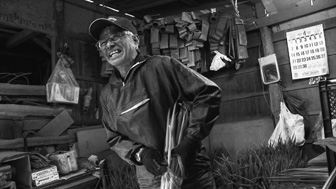The Wages of Resistance: Narita Stories
(Sanrizuka ni ikiru) JAPAN / 2014 / Japanese / Color, B&W / DCP / 140 min
JAPAN / 2014 / Japanese / Color, B&W / DCP / 140 min
Director, Photography: Otsu Koshiro
Director, Editing: Daishima Haruhiko
Music: Otomo Yoshihide
Stills: Kitai Kazuo
Sound Editor: Takizawa Osamu
Narration: Yoshiyuki Kazuko, Iura Arata
Producers: Akamatsu Ryuta, Daishima Haruhiko
Planning, Production: The Wages of Resistance Production Committee
Production Company, World Sales: Sukoburu Kobo
Forty-five years after Summer in Narita (1968), cameraman Otsu Koshiro once again turns his camera on the farmers of Sanrizuka. The young men and women who carried on farming after Narita Airport had its abnormal opening, talk about their lives as farmers standing up to power. Steady in the belief that it is they who will decide their own destiny, their eyes are still sharp after long years of sorrow, pain and suffering. While making comparisons to the many problems caused by government-directed public works today, this film employs a quiet tone in confronting the consequences of the building of Narita Airport.
[Director’s Statement] The Wages of Resistance: Narita Stories is the last work of Otsu Koshiro, who both directed and shot this film. Otsu, one of the great cinematographers of post-war Japanese documentary film, died of lung cancer on November 28, 2014, just after the premiere.
I visited Otsu in the hospital often. As his breathing became more labored, his consciousness began to cloud over for long periods. One day I spoke with him during one of his more lucid moments.
Daishima: It is almost time for the premiere. I want you on stage to introduce the movie.
Otsu: In this film I was finally able to film people. Thank you.
Moments later, his consciousness clouded over again and our conversation remained unfinished. I walked home in a state of confusion.
Why did Otsu, who worked closely with Ogawa Shinsuke and Tsuchimoto Noriaki and was always filming people, say that in this film he had finally managed to do so?
We began shooting The Wages of Resistance in the summer of 2012, forty-four years after Otsu first turned his camera on the people of Sanrizuka in Summer in Narita (Dir. Ogawa Shinsuke, 1968). Today, airplanes still fly above the farmers who continue to oppose the airport.
During the latter part of the filming, Otsu and I rented an apartment near Narita Airport and began living there. In the evenings we sometimes talked about the past.
Otsu: Ogawa made Summer in Narita into a story about people in struggle. While I was trying to film people living.
Daishima: Is that why you parted company with Ogawa?
Otsu: That’s not the only reason . . .
I finally realized what Otsu had meant. He had finally filmed the people of Sanrizuka. That’s how serious the falling out between Otsu and Ogawa was forty-four years ago.
 Otsu Koshiro
Otsu Koshiro
Born in 1934, Otsu joined Iwanami Productions in 1958. He worked there for five years as an assistant cameraman before becoming dissatisfied with the PR film genre and leaving the company. After going freelance, he worked with director Ogawa Shinsuke on The Oppressed Students (1967) and Summer in Narita (1968), with Tsuchimoto Noriaki on Prehistory of the Partisans (1969), Minamata: The Victims and Their World (1971), and many other films. Otsu’s flexible camera work allows close to the skin shots that won him a reputation as the frontrunner of Japanese cinematographers. Later work expanded to feature films such as A Bridge of Tears (1983) by Kuroki Kazuo and Business Trip (1989) by Okishima Isao. From the 1990s, he actively worked with the next generation of filmmakers including Sato Makoto, John Junkerman, Fujiwara Toshi, and Kumagai Hiroko. His debut as a director is Butoh Dancer Kazuo Ohno (2005). Otsu passed away in 2014.
 Daishima Haruhiko
Daishima Haruhiko
Born in 1958. After working for Hakuhodo, he established Sukoburu Kobo in 1988. He produced Pineapple Tours (1992) and has produced other films and TV programs. For YIDFF ’93, he co-coordinated the First Nations Moving Images program. He ran the cinema Box Higashinakano from 1994 to 2003. His films as director include Regarding the Lives of Others (2011, YIDFF 2011).
